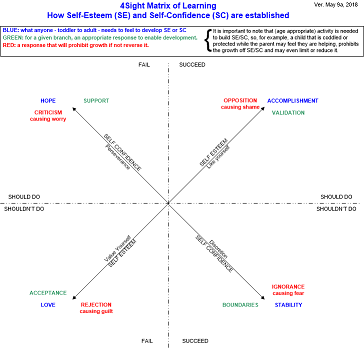When I was creating the first round of content for 4SightModel.com, I knew that I could interactively help people. I had always done that with friends and family. It was a skill that was further honed over more than thirty years as a project manager. However, I didn’t have an algorithm that I could follow and, from a business perspective, it made a lot of sense to have one. It would give me a guideline to follow, it would help explain to others how this new process worked, and it was something that I could use to create a software program / app, something I still plan on doing.
During my first year, I expanded the 4Sight Model into a full-scale behavior management system. To do that I had to define the behavior we should expect from all adults, then figure out how to rear a child to obtain those requirements. I also had to have a system to determine what deficiencies an adult might have and then remediate them to get the needed improvement.
While analyzing that rearing part, I came up with the diagram below. I thought about how you create a system from scratch. In effect, you have to teach children everything. And the way you do that is by employing building blocks. You present them with ever-expanding responsibility while ensuring they are ready for it. Everyday is class. Every interaction is a lesson. You only want to do what you have to for them but you also don’t want to push them too fast. It’s a delicate balance. The benefit of the diagram that the two diagonals corresponded with fostering SE and SC. There’s a lot more to how I came up with this chart, but the key part is that it lead me to another part of my theory.
What I surmised was that we have four needs that we need to self-sufficiently supply by the time we are an adult. Optimally, a good foundation is in place by age three, but we literally have another 15 years after that if there are any deficiencies because our brains remain forever plastic. However, a) there is no known theory like this as far as I know, b) if there is, it certainly isn’t propagated unto parents which is part of the problem and c) the primary caregivers enabling whatever deficiencies are in place by age three are likely reinforcing them throughout your entire youth. As a result, you can see why SE and SC issues would be prevalent in adults. We have neither the knowledge nor tools to ensure emotional wellness in our children.
Those four needs are met by our asking - in our subconscious really - these questions on a conceptual basis:
Am I good?
Do I have value?
Do I have discretion
Will I persevere?
It is interesting to note that the first two questions govern how we look at the past and the second two how we look at the future. Also, each group has a group stakeholder (2 and 3) and a self-stakeholder (1 and 4). Meaning, we need others (at least initially) to teach us we have value. We show ourselves we are good by doing the right thing. Similarly, we need to be able to consider others when we are making a decision (discretion) but it is usually up to us to succeed once that choice is made (perseverance). Yes, we are a group and can help each other out, but it is an unwritten societal / cultural law that we are *supposed* to take care of ourselves.
The takeaway from everything above is that emotions made us a social creature, and that Alignment requires our keeping in balance the opposing drivers of self-interest versus the group's interest.
4Sight | Terms of Service | Privacy Policy | Contact Us | © 2023

